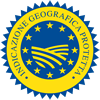Description
Limone Interdonato Messina PGI is a fresh lemon belonging to the species Citrus limon L., deriving from the Interdonato cultivar, a natural lemon/citron hybrid.
Production Area
The production area of Limone Interdonato Messina PGI is on the Ionian side of the Province of Messina, extending from the city of Messina to Giardini Naxos, in the Sicily region.
Production Method
The plantations can be managed with either an integrated or organic method. The cultivation technique can either involve the establishment of new plantations, with the planting of young seedlings, which must be completed by June 30th, or the varietal conversion of already existing lemon groves, which must be carried out in spring or autumn. This cultivar is highly sensitive and demanding, therefore the irrigation and pruning stages are crucial for the correct development of the trees. Irrigation must be carried out between April and October, and pruning between February 15th and September 15th. The trees flower no more than twice a year and the harvest is carried out by hand from September 1st to April 15th. However, the operations are usually concluded by the end of February.
Appearance and Flavour
Limone Interdonato Messina PGI is a medium-large size, with an elliptic shape; the ripe fruit is yellow with dull green ends. The epicarp is shiny and thin, while the pulp is yellow, with a very sweet, mellow flavour due to the low content of citric acid.
History
The lemon tree has been present in Sicily since the Byzantine-Arabian era. It was initially used either as an ornamental tree or for local consumption, becoming the core of the socio-economic fabric from the second half of the 16th century, with the development of an actual lemon growing industry. During the 19th century, the entire Ionian side of the Province of Messina was known as the “land of evergreen gardens”, and every aspect of daily social, commercial and economic activities gravitated around this particular variety, at the time known as the “special” or “fine” lemon. The origin of the Limone Interdonato Messina PGI cultivar can be traced back to between 1875 and 1880, when the Garibaldian colonel Giovanni Interdonato (from whom the lemon takes its name) did around 200 grafts before obtaining the right citron/lemon hybrid. After having fought during the Sicilian rebellions together with Garibaldi’s patriots, and having governed under the banner of Savoy in a large part of the Messina area, he retired to his villa in Ali Terme, called Reitana, where the mother plants still grow today. In 1860, he acquired a passion for the cultivation of citrus fruits, which led him to cross-breed a citron tree with the ariddaru, a local lemon tree, obtaining the fruit that is today called the Limone Interdonato Messina PGI.
Gastronomy
Limone Interdonato Messina PGI should be kept in a cool, dry place, ideally inside a paper bag. Thanks to its particularly sweet flavour, this lemon is delicious eaten on its own, with or without the peel, or served as a salad, thinly sliced and dressed with oil, vinegar and salt. In cooking it can be used for a wide range of recipes, such as the typical limone zuccherato (sugared lemon) or to make various types of beverages. One of the best techniques to squeeze out the juice is to cut the lemon vertically, following the natural direction of the segments.
Marketing
The product is marketed as Limone Interdonato Messina PGI. It is sold loose or packed in wooden, plastic or cardboard containers, vented crates, or net bags, with a maximum weight of 5 kg. The permitted categories are Extra and First.
Distinctive Features
Limone Interdonato Messina PGI is characterised by its early-ripening and particularly sweet, mellow taste, given to the low citric acid content: it is therefore delicious eaten on its own and the best variety to serve with tea.



























